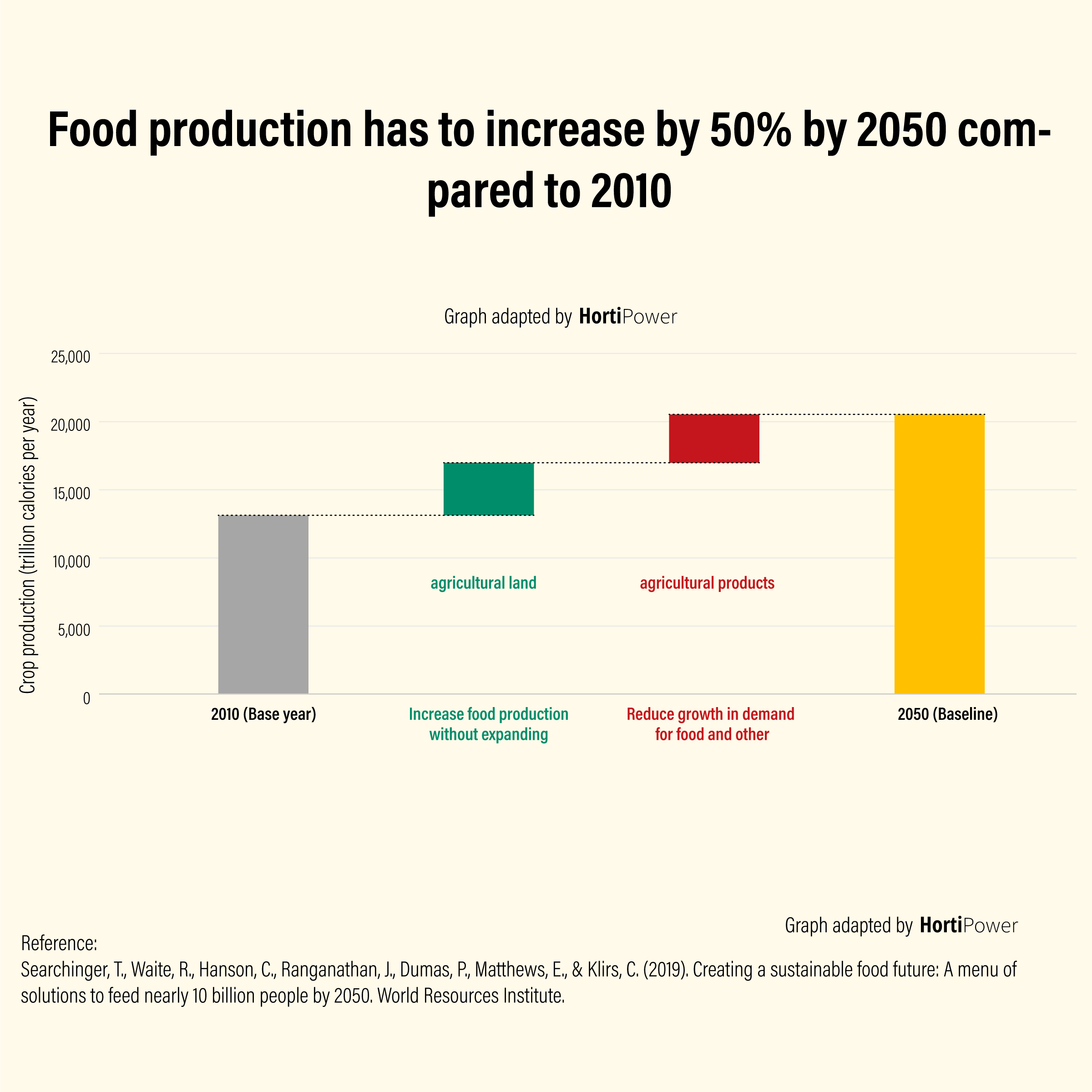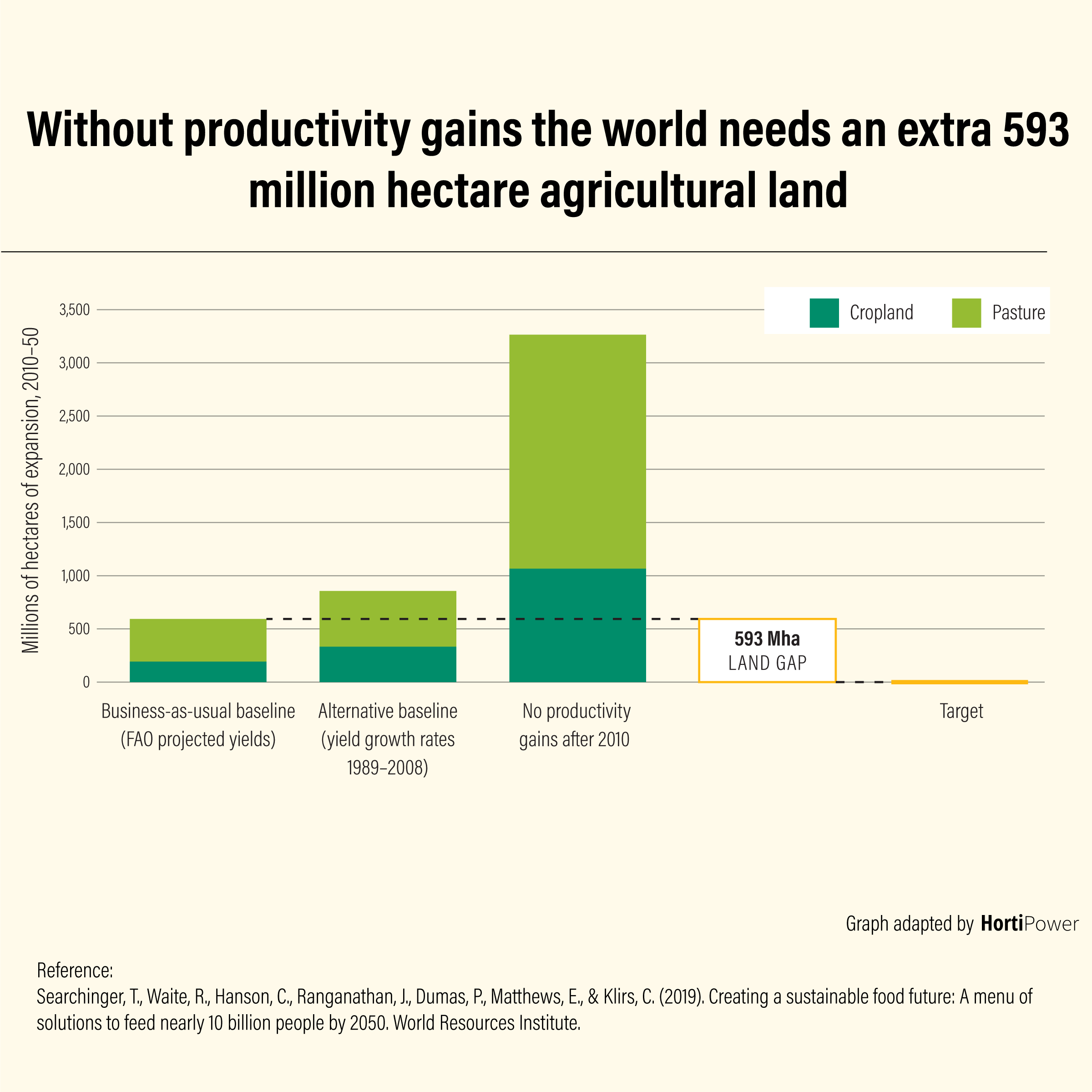At HortiPower we dream, think and work to help farmers and growers to grow better, more sustainable and make an impact in their local community with fresh, high quality plants and greens. The challenges with food production are large and together with scientists, engineers, farmers and consumers we can create a better food ecosystem. In this article some of reasons why we need to work on food production. By Jille Kuipers
Table of Contents
- Food production needs to increase
- Productivity gains should also reduce carbon emissions
- More mouths to feed
- 2.3Bn people experience food insecurity
- The world would need an extra 593 million hectare agricultural land, if there are no productivity gains
- Indoor farming with sustainable energy?
- A food production system with soil-based farming And Greenhouses And Indoor farming
- References
Food production needs to increase
The world’s food production needs to increase by 50% by 2050 compared to 2010 levels, the primary reason for this increase is the need to feed the growing population of the world (Searchinger et al, 2019).

Productivity gains should also reduce carbon emissions

More mouths to feed
The latest projections by the United Nations suggest that the global population could grow to around 9.7 billion in 2050. In November 2022 the estimated population is 8 billion. A significant increase vs 1950 with a population of just 2.5 billion (World Population Prospects 2022).

2.3Bn people experience food insecurity
After increasing sharply in 2020, moderate or severe food insecurity remained stable at the global level despite increases in every region except Asia. However, severe food insecurity increased globally and in every region (The State of Food Security and Nutrition in the World 2022).

Economic development can make the nutritional challenge easier to solve. As per capita incomes rise, people can afford to eat more food and to get food from different sources. As incomes rise, food consumption rises too. The incremental increase often seems to rise the fastest in the poorest countries and more slowly in richer countries, according to the ‘Kuznets curve’. Economic development is therefore a means towards a more food secure world, but at the same time makes the food production challenge even larger.
The world would need an extra 593 million hectare agricultural land, if there are no productivity gains
There is also the question of availability of more arable land. On top of that there are water challenges and heat increases which negatively affect crop yield.

- More food (productivity challenge)
- More sustainable production (or in a way that reduces impact on soil health, water use, land use, carbon emissions)
- More accessible (affordable) and farming as a way to boost economic activity in a community
One of the most promising approaches to help address the food production challenge, and in particular for fresh, locally grown food, is with indoor farming.

Indoor farming enables growing in a controlled environment, regardless of adverse weather circumstances. According to a study the lettuce yield can be 80kg/m2/year in a vertical farm compared to 4kg/m2/year with traditional farming. It also allows for zero pesticide use, as the environment is generally clean and can be controlled. This prevents possible pollutants on food and prevents environmental pollution. In addition indoor farms are serving a hyper local community, with on average a 43 food kilometers compared to 3200 kilometers with traditional or greenhouse based farming. Water can be reduced by 99%, as hydroponic and aeroponic systems allow for a precise water management on the crops e.g. 1 Liter of water per 1KG of lettuce vs 250 Liter of water with traditional farming. Because of these savings CO2 emissions drop to 158 CO2 kg/ton of lettuce with indoor farming compared to 540 CO2 kg/ton of lettuce with traditional farming.
Indoor farming with sustainable energy?
The biggest resource drawback for indoor farming are three-fold: Energy use, property availability and manpower. Energy Indoor farming uses controlled environment techniques with lighting, HVAC and other equipment. It is estimated that it can use up to 250kWh/kg/year. And to make it more sustainable indoor farming should aim to use sustainable energy sources.

There are signs that this energy will be increasingly available. In Dubai for example the cost of solar energy broke a record low in 2016 at $0.0299/kWh. In the USA the cost of solar energy may reach a (leveraged cost of energy) LCOE of $0.004/kWh in 2029 according to news reports, partly due to the measured in the US Inflation Reduction Act (IRA).

And there are those businesses and households that have installed solar panels with surplus capacity. In the Netherlands, which has the second-highest number of solar panels per capita in the world, surplus energy delivered back to the biggest energy company Essent is 0.055/kWh.
Indoor farming are most popular in urban centers where property prices are generally high. Labor costs at indoor farms are generally much higher than soil based or greenhouse farms. This is in part because of higher skilled work and also because of more transparency and job alternatives in urban centres. Operationally the challenges for indoor farms are that each farm has their own growth model and operating guidelines. There is yet little data sharing on high-yield, low-cost growth models within the sector. And to improve efficiency a better understanding of crop science and different crops might be useful for the future. Staple crops such as wheat, potato and rice are not yet produced at a large scale in indoor farming, although some initial research projects are carried out.
A food production system with soil-based farming And Greenhouses And Indoor farming

Whilst each growing technique has its own merits and disadvantages, we think that indoor farming will be able to co-exist alongside soil farming and greenhouse facilities. More food is needed and different production techniques can contribute to a more resilient food production sector. Each of its techniques has its own improvements and challenges towards a more affordable, equal and environmentally-friendly future. One of the lessons we can learn from technological innovation is that old and new technologies can often co-exist, but once performance barriers are crossed, the new technology may end at a higher plateau.
References
Searchinger, T., Waite, R., Hanson, C., Ranganathan, J., Dumas, P., Matthews, E., & Klirs, C. (2019). Creating a sustainable food future: A menu of solutions to feed nearly 10 billion people by 2050. World Resources Institute.
Gerland, Patrick & Hertog, Sara & Wheldon, Mark & Kantorova, Vladimira & Gu, Danan & Gonnella, Giulia & Williams, Ivan & Zeifman, Lubov & Bay, Guiomar & Castanheira, Helena & Kamiya, Yumiko & Bassarsky, Lina & Gaigbe-Togbe, Victor & Spoorenberg, Thomas. (2022). World Population Prospects 2022: Summary of results.
FAO, IFAD, UNICEF, WFP and WHO. 2022. The State of Food Security and Nutrition in the World 2022. Repurposing food and agricultural policies to make healthy diets more affordable. Rome, FAO. https://doi.org/10.4060/cc0639en

